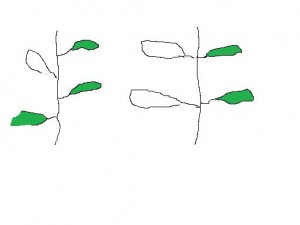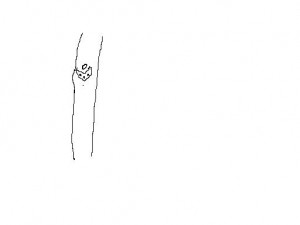Following, is a continuation of last week’s challenge of identification of the maple tree, in winter.
 What did you notice about the maple, other than the leaves, which are not present in winter? Did you notice that they come in pairs, each node having 2 leaves, opposite each other? The majority of hardwood trees have 1 leaf per node, occurring on alternating sides of the branch. Did you notice that the branching also occurs in pairs? Maple (Acer) is 1 of 4 hardwood tree genera that has opposite branching. The others are ash (Fraxinus), dogwood (Cornus) and horsechestnut (Aesculus). The first letters of maple, ash and dogwood spell the word MAD. Add the horsechestnut and you have a MAD HORSE. Maybe this will help you remember it. All other hardwood trees are alternate.
What did you notice about the maple, other than the leaves, which are not present in winter? Did you notice that they come in pairs, each node having 2 leaves, opposite each other? The majority of hardwood trees have 1 leaf per node, occurring on alternating sides of the branch. Did you notice that the branching also occurs in pairs? Maple (Acer) is 1 of 4 hardwood tree genera that has opposite branching. The others are ash (Fraxinus), dogwood (Cornus) and horsechestnut (Aesculus). The first letters of maple, ash and dogwood spell the word MAD. Add the horsechestnut and you have a MAD HORSE. Maybe this will help you remember it. All other hardwood trees are alternate.
 Now, what did you notice about the scar left on the branch, after you pushed the leaf off? Did you see that it was a thin crescent, forming a semicircle around the bud? Did you notice 3 bumps on the leaf scar, 1 in the center, and 2 more on the sides? These are called bundle scars. The sugars and organic compounds made in the leaves (photosynthesis) go into the leaf’s veins, into the vascular bundle tissue and are transported to all other parts of the tree. Opposite branching, crescent leaf scars and the 3 bundle scars are the features that enable you to positively identify a maple tree, in winter.
Now, what did you notice about the scar left on the branch, after you pushed the leaf off? Did you see that it was a thin crescent, forming a semicircle around the bud? Did you notice 3 bumps on the leaf scar, 1 in the center, and 2 more on the sides? These are called bundle scars. The sugars and organic compounds made in the leaves (photosynthesis) go into the leaf’s veins, into the vascular bundle tissue and are transported to all other parts of the tree. Opposite branching, crescent leaf scars and the 3 bundle scars are the features that enable you to positively identify a maple tree, in winter.
Why do hardwood trees shed their leaves in the winter? What advantage is this to the tree? Think that one over and we’ll have more on this next week.
